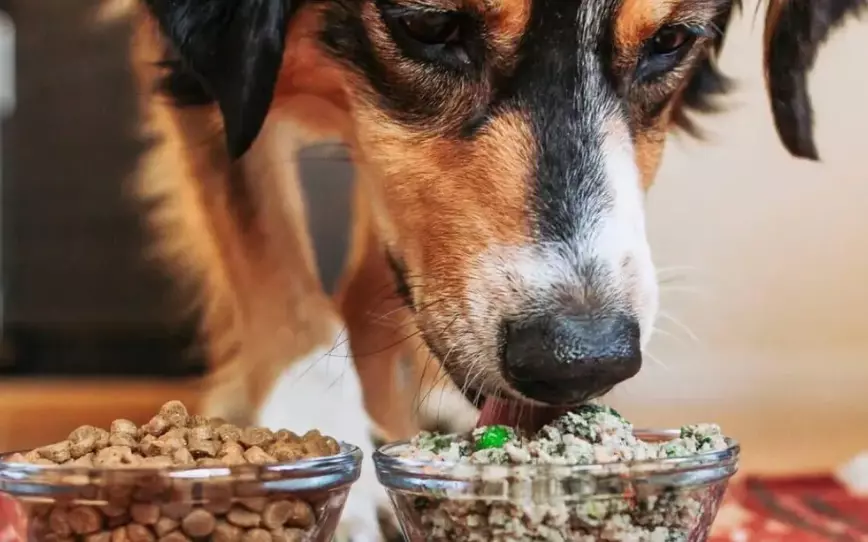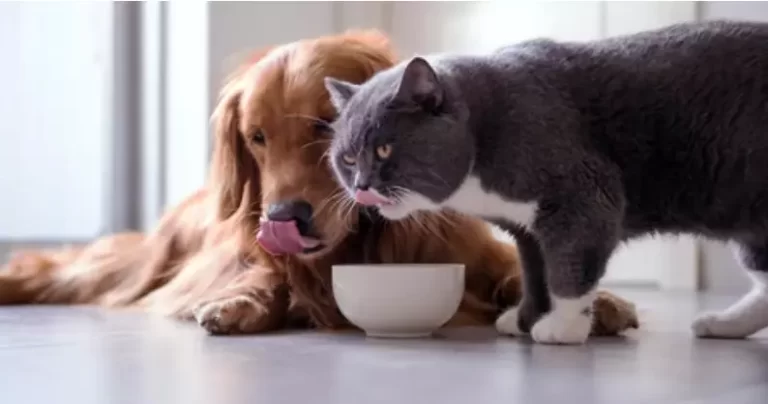Pros And Cons Of Putting Water In Kibble
Table of Contents
Water is a common additive to dry pet food, but it can be detrimental if not done correctly. It is important to know the pros and cons of adding water to your dog’s kibble before doing so.
This will help you determine whether or not this is something that you should do for your pup. There are many positives, including added hydration, increased nutrition absorption, and improved palatability.
However, there are some negatives like dilution of nutrients and susceptibility to harmful bacteria growth. This article will explore all the positive and negative aspects and Pros And Cons Of Putting Water In Kibble as well as other benefits of giving healthy food to your dog. Let’s explore it!
What is dog kibble?
Dog kibble is what a dog’s dry food is made of. It typically contains meat, corn, and wheat in some form or another. This mixture provides your pup with the nutrients they need to stay healthy.
The kibbling process begins by cooking down the ingredients into a pulp-like consistency. After that step has been completed, heat must be applied once more to cook further what will become the final product.
When these are finished being cooked, each one gets stamped out by machine presses on conveyor belts moving through an assembly line until all have formed their unique shape because no two pressings turn out exactly alike.
Finally, the kibbles cool before packaging so that they can be sent on their way to your local pet store.
Why do we feed our dog’s kibble?
There are many different types of pet foods on the market; why should you feed kibble?
Kibble is a dry food that has been molded into kibbles. You should consider feeding your dog kibble because it contains all the nutrients they need to have an active lifestyle.
Dogs are able to get their daily recommended amount of vitamins and minerals in just one bowl full of dried-up treats. They can stay energized for longer periods without getting tired out easily, which helps when running around with friends or playing games at home.
How to make your dog food at home?
It is very important that your dog’s diet be one of the best you can give them. you can also make your dog food at home and save a lot of money. How to make your dog food at home? It is very simple:
- Buy meat in bulk, when it’s on sale;
- Blanch the vegetables you will add;
- Cook everything together with rice or pasta (or both).
- Store all ingredients separately in containers until ready to use.
Now let’s discuss what should be included in such a diet: You can prepare this mixture yourself by buying offal for cheap from supermarkets, beef and chicken without bones and skin, which you mix up together along with brown rice and/or green veggies like broccoli, spinach, etc., adding some olive oil and kelp powder as well.

Can I put some water in the dog’s kibble?
You can add a little bit of boiled water to dry food, especially if it is not eating well enough on its own.
If you’re noticing that your pup isn’t eating like they normally do or are simply looking for ways to improve their digestion system, adding vegetables (cooked thoroughly) into their meal may be helpful; these veggies will also provide them with additional nutrients.
Disadvantages of adding water in Dog Kibble
1. Dog food becomes wet and soggy
2. Dogs may not like the taste of it
3. It can make dogs feel sick or cause stomach problems
4. If they drink too much water, they may have to go more often
5. Wet dog food is messy and hard to clean up after
6. Adding water to dry dog food can change the nutritional content of your pet by adding unnecessary calories from fat, sugar, and salt.
Benefits of dry dog kibble
1. Dry kibble is the most economical option for pet food.
2. It’s easy to store and can be left out for a few hours without spoiling.
3. It doesn’t need to be refrigerated, so it’s perfect for travel.
4. Your dog will love you more if they’re fed dry kibble because it tastes better than wet food.
5. Dry kibble is healthier than wet food because there are no added preservatives or sugars in the ingredients.
6. When your pets drink from their bowls, you don’t have to worry about them splashing water all over the place.
Disadvantages of dry dog kibble
Dry kibble is not beneficial for dogs. It can lead to obesity, heart problems, and diabetes if fed in large quantities.
Additionally, it causes dental issues as well since the food often sticks between teeth or gets stuck around gums which leads to plaque formation resulting in bad breath, tooth decay, and even growth of harmful bacteria that damage gum tissue leading to periodontal disease.
Dogs are meant to neither eat dry nor sweet foods but a rather meat-based diet with high moisture content provided by water or other liquids.
Dry dog food does not provide your pet’s body with the proper hydration needed because 70% of the dry kibble is carbohydrates, and only around 12% of it comes from protein.
Dry food can cause constipation because dogs will be forced to eat more in order for their bodies to gain enough hydration, which may not happen with a dog’s natural water consumption level.
The best approach to avoid such issues and keep your pet safe is by feeding them moist foods like canned or fresh meats, fruits, and vegetables alongside high-quality dry dog food that does not contain grains making its fiber content lower than what you would expect.
Grain-free diets are usually rich in different fibers but are also far less likely to lead to adverse health conditions when compared to commercial ones (which often do include sweeteners).
Why should you avoid dry kibble if your dog has allergies or digestive problems?
There are many reasons why you should not feed your dog dry kibble.
First, most dogs don’t chew their food well enough to break down the ingredients, and they can swallow huge chunks of indigestible foods without even knowing it.
Second, dry kibble is high in carbohydrates, and these ingredients are not easily digestible for dogs.
Third, the majority of dog foods on the market today contain a lot of poor-quality meat byproducts, which include dark meats from animals that have been slaughtered older than they should be. This can lead to higher cholesterol levels or even heart disease later on in their life.
Fourth, most canned food has “meals” as one of its top two ingredients.
Last, feeding your dog dry kibble can lead to obesity and diabetes. Even if you feed your dog twice a day, he’ll still be hungry because the food is not reaching his stomach.
Tips for feeding a picky eater
1. Introduce new foods to your dog slowly.
2. Make sure that you’re giving them a variety of different types of food, including vegetables and meat.
3. Don’t give them human food – they can’t digest it as well as other foods.
4. Offer their food in small portions, so they don’t fill up on one thing too quickly.
5. Try feeding your dog a raw diet or home-cooked meals instead of processed ones from the store.
6. Keep an eye out for any allergies, particularly if you’ve recently switched to a new brand of kibble or wet food.
How to feed your dog inappropriate manner?
1. Dogs are carnivores, so they need meat to stay healthy.
2. A dog’s nutritional needs are similar to a human’s – they need carbs, proteins, fats, vitamins, and minerals.
3. Dog owners should consider what their pets eat when choosing food brands for them.
4. There are many different types of commercial pet food available on the market today.
5. It is important to read labels before buying any type of pet food because it can contain ingredients that may not be good for your dog or cause an allergic reaction.
6. The more natural the ingredients in the diet are, the healthier it will be for your pup.
Things you should not give to your dogs
1. Chocolate
2. Alcohol
3. Onions
4. Garlic
5. Grapes, raisins, or any other fruit that can be toxic to dogs
6. Avocado (unless it is mashed up really well).
How to choose the best dog food for your dog?
1. Start by consulting a veterinarian.
2. Consider the age, size, and weight of your dog.
3. Decide on a type of food – dry or wet.
4. Choose a brand that is high quality and has an AAFCO seal.
5. Make sure it’s tailored to your dog’s needs (for example, some dogs need more protein than others).
6. Read reviews from other pet owners to see what they think about the product before you buy it for your pup.

How much you feed your dog
1. Dogs are omnivores, meaning they can eat both meat and vegetables.
2. You should feed your dog a high-quality diet that is well balanced.
3. Feeding your dog too much will lead to obesity, which can cause other health problems like heart disease or diabetes.
4. A good rule of thumb is to feed them 2 cups worth of food per day for every 10 pounds they weigh.
5. You should also make sure you’re feeding them the right type of food – canned food for wet foods, dry kibble for dry foods, etc.
6. If you have any questions about what’s best for your pup, consult with their vet! They’ll know exactly what’s the best option based on their breed and lifestyle needs!
Conclusion of Pros And Cons Of Putting Water In Kibble
There are a lot of pros and cons to adding water to kibble. Some people believe that it can help prevent kidney stones from forming, but others argue that this is not the case.
If you’re confused about whether or not you should put water in your dog’s food dish, we recommend speaking with your veterinarian first.
You may also want to consider what other members of our team have written about how much liquid should go into dry pet foods, as well as their thoughts on wet vs. dry cat food bowls!
- 1xbet официального Сайт Казино Игровыми Автоматами 1хбет - April 17, 2024
- Бездепозитные Бонусы За Регистрацию и Онлайн Казино 202 - April 9, 2024
- Yeni Deneme Bonusu Veren On Line Casino Siteler - January 31, 2024






